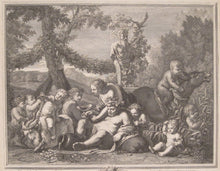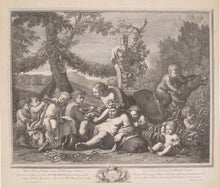Jacques Coelemans after Francisque Milet. "BACCHANALE."
Paris: Mariette, 1744. 13 1/2 x 16 (platemarks). Line engraving. Margins. Time toning. A few abrasions on surface.
The print was made for a portfolio by Coelemans (b. Anvers 1654-d. Aix-en-Provence 1735) in celebration of the paintings and drawings in the collection of Jean-Baptiste Boyer d'Aguilles (1645-1709). Besides being a painter and engraver in his own right, Boyer was the head of a powerful family, and after his death, his wonderful collection of Renaissance art remained in the family. Jacques Coelemans being from the same province wished to commemorate his colleague's collection and flatter the family by including engravings of his pictures in the portfolio entitled Recueil d'estampes d'apres les tableaux des peintres des plus celebres d'Italie, des Pays-bas et de France (Paris: Pierre-Jean Mariette, 1744). The entire work is a beautiful and impressive compendium of fine art that also would have elevated French national pride in the age of Louis XV. The copy of this rare portfolio which we examined in The Free Library of Philadelphia was once owned by Joshua Reynolds, so it could have inspired similar works such as John Boydell's Houghton Gallery with its rich variety of prints after paintings in another great estate.
In "Bacchanale" the old god Bacchus lies intoxicated in a garden designed around a statue of Priapus. This picture by Francisque Milet (Anvers 1644- Paris 1680) is an ebullient emblem of the stupor induced by the pagan fertility cult. Ariadne (fruitful mother of barley) helps Bacchus hold his wine goblet while to the right a satyr rides away on an ass (symbol of lust), and to the left cherubs mount a ram (symbol of aggressiveness). The entire scene is ensconced with fruitful symbols of fertility such as grapes, wheat, nuts and an oak cluster on Bacchus' head.





